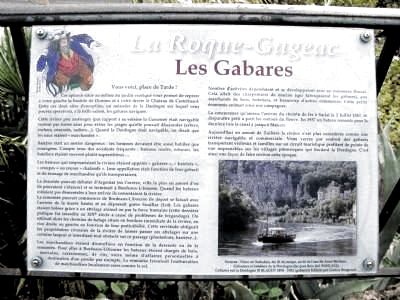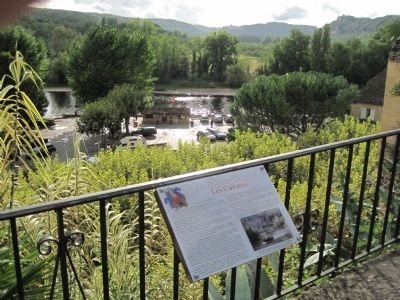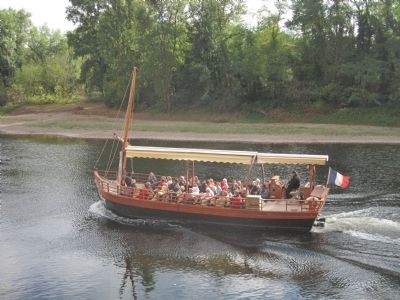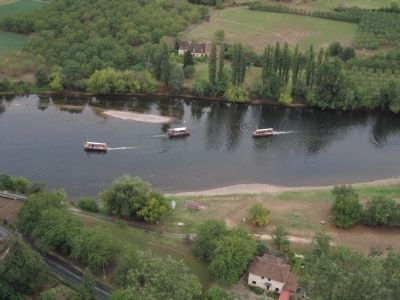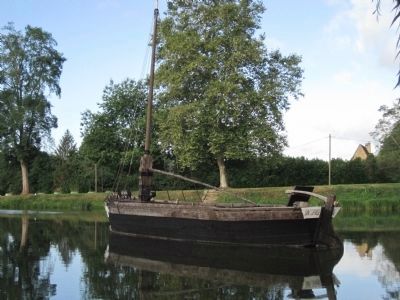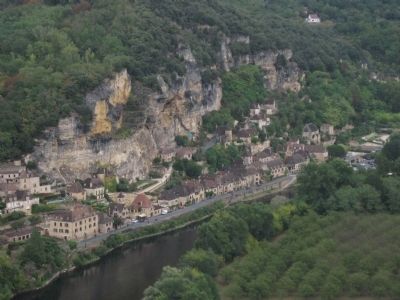Les Gabares
La Roque-Gageac
Cet aplomb situé au mileiu de jardin exotique vous permet de repérer à votre gauche la bastide de Domme et à votre droite le Château de Castlenaud. Entre ces deux sites d’exception, un méandre de la Dordogne sur lequel vour pouvez apercevoir, à la belle saison, les gabares naviguer. Cette rivière peu amenagèe (par rapport à sa voisine la Garonne) était navigable surtout par fortes eaux pour éviter les pièges qu’elle pouvait dissimuler (arbres, rochers, courants, radiers...). Quand la Dordogne était navigable, on disait que les eaux étaient «marchandes» . Batelier était un métier dangereux: les hommes devaient être aussi habiles que courageux. Compte tenu des accidents fréquent: bateaux coulés, échoués, les bateliers étaient souvent plutôt superstitieux... Les bateaux qui empruntaient la rivière étaient applés «garbares» , «batelets» , «croupes» ou encore «chalands» . Leur appellation était fonction de leur gabarit et du tonnage de marchandise qu’ils transportaient. La descente pouvait débuter d’Argentat (en Corrèze, ville la plus en amont d’où ils pouvaient s’élancer) et se terminait à Bourdeaux-Libourne, Quand les bateaux n’étaient pas démantelés à leur arrivee ils remontaient la rivière. La remontée pouvait commencer de Bordeaux-Libourne (le départ se faisait avec l’arrivée de la marée haute) et ne dépassait guère Souillac (Lot), Les gabares étaient hâlées grâce à un attelage animal ou par la force humaine (cette dernière pratique fut interdite au XIXe siècle à cause de problèmes de brignadage). On utilisait alors les chemins de halage situés en bordure immédiate de la rivière, en rive droite ou gauche en fonction de leur praticabilité. Cette servitude obligeait les propriétaires riverains de la rivière de laisser passer ces attelges sur une certaine largeur et interdisait tout obstacle sur ce passage (plantations, barriers...). Les marchandises étaient diversifiées en fonction de la descente ou de la remontée. Pour aller à Bordeaux-Libourne les bateaux étaient chargés de bois, merrains, carassonnes, de vin, voire même d’affaires personnelles à destination d’un proche par example. La remontée favorisait l’embarcation de marchandises localement rares comme le sel. Nombre d’activites dépendaient et se développaient avec ce commerce fluvial. Cela allait de charpentiers de marine (qui fabriquaient les gabares), aux marchands de bois, hôteliers, et beaucoup d’autres commerces. Cette petite économie animait ainsi nos campagnes. La concurrence qu’amena l’arrivée du chemin de fer
This little river (compared to its neighbor the Garonne) was navigable waters especially strong to avoid the pitfalls that could hide (trees, rocks, streams, riffles ...). When the Dordogne was navigable, it was said that the waters were "market."
Boatman was a dangerous business: men should be as clever as courageous. Given the frequent accidents: boats sunk, stranded, boatmen were often rather superstitious ...
Boats traveling the river were called "garbares", "batelets", "ridges" or "shoppers". Their name was based on their size and the tonnage
The ascent began at Bordeaux Libourne (starting was with the arrival of high tide) and did not go beyond Souillac (Lot), the barges were winched with a team of animal or human power (the latter practice was prohibited in the nineteenth century because of problems brignadage). One then used the towpaths immediately bordering the river, right or left side depending on their feasibility. This required an easement from the landowners bordering the river pass allowing these teams over a certain width and forbade any obstruction on this passage (trees, barriers ...).
The goods were varied depending on the descent or ascent. To go to Bordeaux Libourne boats were loaded with timber, staves, grapevine poles, wine, or even personal belongings of a loved destination for example. Favored for the ascent of the craft, merchandise rare locally such as salt.
A number of activities depended on and developed with the river trade. This ranged from shipwrights (who made the barges), the timber merchants, hotels and many other businesses. This small economy in this way animated the countryside.
Competition, which came with the arrival
The Gabares
Here you are, instead of Tarde!
From this choice site among elegant exotic garden you can find on your left the Domme and right Castle Castlenaud. Between these two exceptional sites, a bend of the Dordogne where vou can see, in the summer, the boats sail.
Topics. This historical marker is listed in this topic list: Waterways & Vessels. A significant historical date for this entry is July 2, 1882.
Location. 44° 49.534′ N, 1° 11.042′ E. Marker is in La Roque-Gageac, Nouvelle-Aquitaine (New Aquitaine), in Dordogne. Marker can be reached from Les Cotes. Touch for map. Marker is in this post office area: La Roque-Gageac, Nouvelle-Aquitaine 24250, France. Touch for directions.
Other nearby markers. At least 8 other markers are within 8 kilometers of this marker, measured as the crow flies. Géologie, écologie et histoire de La Malartrie (approx. 0.6 kilometers away); La Dordogne et la navigation (approx. 1.2 kilometers away); Jacques de Maleville (approx. 3.4 kilometers away); Chateau Feodal de Beynac (approx. 3.4 kilometers away); Jacquou le Croquant (approx. 3.6 kilometers away); Perigord Noir (approx. 6.2 kilometers away); Hôtel de Cervalè (approx. 7.4 kilometers away); Hôtel de Carbonnier de Marzac (approx. 7.4 kilometers away).
